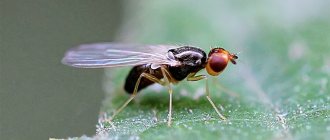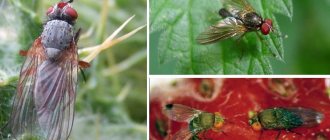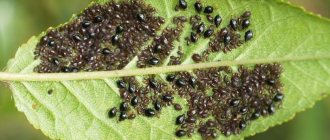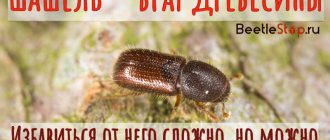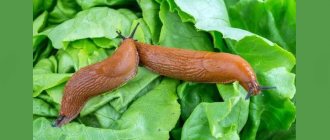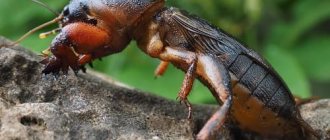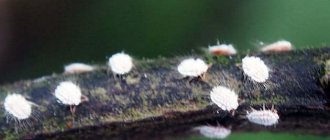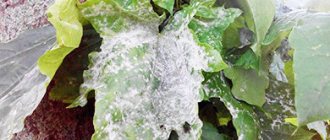Having seen long, winding, lumpy swellings of the earth in the garden, one can say for sure that it was a mole cricket making its underground passage. Such paths are especially noticeable on wet ground. Typically, such swellings on the surface of the earth have a length of 10 cm. And if you look around, you can see either nibbled stems of tomatoes, eggplants, peppers, cucumbers, or a couple of pea-sized holes leading into the depths of the soil and located next to each other. If you find this on your property, then you are undoubtedly interested in the question: “how to get rid of mole crickets in the garden forever?”
In order to create ventilation in the nesting box, the female breaks through paired holes, from which it can be determined that there is a clutch deep in the ground. And perhaps the young have already hatched there, and after some time they will attack the roots, stems and tubers. But people hope to get a harvest, and not stubs from tubers and seemingly mowed seedlings. The mole cricket loves young cabbage sprouts, which is why this insect received another name: “cabbage weed”.
What does a bear look like: photo
An adult mole cricket is impressive in size for an insect. With an abundance of food, it can reach 5-6 cm in length. The front legs resemble short, thickened claws, only they are not forked, like a crayfish, but have 4 powerful teeth. She uses her paws like shovels to dig underground passages. There are 2 more pairs of paws on the abdomen. The hind ones are the longest, like those of a grasshopper.
The hard, chitinous dorsal covering of the body of an adult is dark brown in color and appears shiny due to numerous golden hairs. The mole cricket has a wide head and a long (almost 3 times longer than the head) abdomen. The head contains strong jaws, tentacles, large eyes and long whiskers. Under the knees of the front legs in a deep fold are the ears.
What does a bear look like (video)
The wings of the mole cricket are well developed; when folded, they appear to be bent downwards in cords and protrude from under the short elytra. Thanks to its wings, it can fly quite long distances. Lives underground, but at the same time, not only flies well, but also runs fast.
The mole cricket overwinters in compost heaps and in the ground, at a depth of 1 m; the larvae of the first year of life in winter do not fall lower than 20-25 cm. When the soil warms up to 12-15 ° C, the insect comes out of hibernation. Mating of insects occurs in the spring. Offspring will appear in warm weather in summer. Each nest can contain several clutches. Each clutch contains from 50 to 400 eggs. From oval yellowish-gray 2 mm eggs hatch wingless larvae, which in appearance are similar to gray six-legged spiders.
Mole cricket masonry
For the first 20 days of life, the larvae live in the clutch, and then crawl into burrows, make new passages and begin to actively feed on roots, fruits and seeds. When the nest is torn apart, it is clear that the grown larvae are very active, run fast, and can even jump. The age of the larvae is divided into several stages of molting: the youngest are 15 mm in length, the larvae of the 4th stage already have the rudiments of wings, the larvae molt up to 10 times. The larvae reach adult size only the following year. The full development cycle of the pest lasts 2 years.
Security measures
Potent synthetic compounds designed to combat harmful insects require compliance with certain safety rules.
When carrying out disinfestation:
- Wear a suit made of thick rubberized material.
- To protect the eyes and respiratory tract, use sealed goggles and a gauze bandage or respirator.
- Pesticides dissolved in organic liquids can cause burns and allergic reactions upon contact with the skin. To work with them, wear closed overalls.
- Solutions are prepared in the fresh air or in a well-ventilated area.
- When treating crops with such potent chemicals as Fastak, take breaks every half hour.
At the end of the disinfestation procedure, take a warm shower. Chemical protective equipment is not brought into residential premises.
Reasons for appearing in the garden
The invasion of cabbage weeds in the garden can be facilitated by adding fresh organic fertilizer to the soil, regardless of whether the product was applied to increase the fertility of the soil on your own plot or on a neighboring one. Mole crickets can overwinter in any manure, although some gardeners claim that fresh chicken manure is used specifically to get rid of the pest. The second reason for the appearance of cabbage mushrooms can be waterlogged mulched soils, as well as lands where groundwater is located near the surface layer.
Lures
In a summer cottage, it is easy to make baits to kill crayfish using different grains. Poison (boric acid, insecticides) is added to cereals as active ingredients.
Several recipes:
- steamed grain (corn, wheat) + Metaphos;
- steamed peas (1-1.5 kg) + Regent preparation (ampoule);
- 0.5-1 kg of porridge (buckwheat, pearl barley, oatmeal) + Parachute (ampoule);
- crumb of black bread + sulfur of matches.
Baits are scattered between rows in beds, under plants, and placed in pest holes.
On a note! To attract mole crickets for scent, add a couple of tablespoons of unrefined vegetable oil to porridge or steamed grain.
Such baits must be used carefully, keeping domestic animals, chickens, geese, and ducks away from the area.
How to get rid of mole crickets forever
Several generations of gardeners can fight mole crickets on the same plot of land. The result will be positive only when this is done not by a single farm, but by the majority of gardeners in the area. But, in any case, it is possible to reduce crop losses even when you do not have to count on the support of your neighbors.
After all, sometimes there may be people living nearby who, due to age or strength of health and spirit, are not able to dig holes in order to destroy the egg-laying cabbage grass; set traps and then manually destroy still living insects; make protective fences from plants with roots that are poisonous to the pest; use chemicals - some of them can be expensive.
Purchased funds
Chemicals used to combat mole crickets are mainly toxic substances of contact-intestinal action. Chemical reagents included in such products as “Parachute”, “Grom”, “Bankol”, “Medvetoks”, “Rembek”, “Antimedvedka”, “Vofatoks”, “Aktara”, “Antikhrushch”, “Metafos” affect the nervous system. the cabbage system, after which paralysis and death of the insect occurs. These products act not only on mole crickets, but also help get rid of other pests in the garden.
Usually these products are harmless to plants and warm-blooded animals and people. The duration of action of chemicals is from 15 to 30 days, then they disintegrate in the soil into neutral components. The preparations must be diluted according to the manufacturer’s instructions and the solution should be sprayed onto the plantings, and also added to porridges seasoned with aromatic sunflower oil, which are then used as bait. Baits are laid out near places where insect passages are visible, in holes sprinkled with earth around plants, in the aisles.
When using chemicals, you must first study the manufacturer's instructions and protect yourself from the harmful effects of toxic reagents.
Biological agents that destroy cabbageweed are not packaged in bags or glass flasks, but crawl, fly and run on their own. Chickens, hedgehogs, starlings, crows, toads and frogs, even some domestic cats, having once tasted the mole cricket, always hunt for pests as soon as they see them on the surface of the earth. A family of starlings, for which a birdhouse will be hung on the ridge of a garden house, will, of course, not be able to completely get rid of insects, but will significantly reduce their number.
Many gardeners carry out protective plantings around their beds. For fences, lupine bushes are used, the roots of which contain a toxic substance, which, when eaten, kills pests. The American weed (galinzoga) is specially harvested in the period preceding its flowering, and then scattered between the beds. Mole crickets cannot stand the smell of this grass. Low-growing black marigolds (marigolds) with the aroma of their roots and flowers repel not only adult individuals, but also growing insects that are constantly in the ground.
Folk remedies
Kerosene is used to use its smell to drive away harmful insects from vegetable crops. Kerosene in an amount of 50-70 ml is mixed with 1 kg of sand and 2-3 shovels of earth. The mixture is added to the planting holes and spread between the plants.
Soapy water is poured into the discovered holes and passages of pests. Sometimes it is enough to pour only 2-3 liters of water into a hole, with washing powder (the cheapest) dissolved in it, to drive an adult insect out of the ground. In this case, you need to prepare in advance and put on gloves on your hands, because you will have to catch the pest.
Eggshells help protect seedlings from being eaten by mole crickets. Crushed shells, soaked in fragrant vegetable oil, are laid out to a depth of 3 cm around the plant at the time of planting in the hole. The insect, crawling towards the root to follow the smell, stumbles upon the bait, swallows it and dies.
Karbafos is used for poisonous baits made from boiled bran or cereals. For example, for 1 kg of boiled oats, use 50 g of unrefined cold-pressed sunflower oil and 50 g of karbafos. Mix everything thoroughly. The bait is laid out in shallow holes around the garden, which are covered with earth so that birds and animals cannot eat them and die along with the mole cricket.
The trap can be a champagne bottle, dug into the ground at an angle of 20-30° with a depth of 2-3 cm. A small amount of either beer, wine, or sweet bait is poured into the bottle. The neck of the bottle must be covered with one layer of gauze - insects gnaw through the fabric and fall to the bottom of the bottle, from which the owner of the garden will subsequently remove it.
Some mole crickets bypass protective rings made from cut plastic bottles quite easily, penetrating to the roots of the plantings underneath. But still, many gardeners manage to save the crop from the pest by placing plastic rings up to 7 cm high on the seedlings at the time of planting in the ground. The main thing that needs to be done is to bury the ring into the soil by 3-4 cm.
Description of the insect and the damage caused
The mole cricket is a dark brown insect. The length of the body is 5–8 cm. The pest has a gnawing type jaw apparatus. The body of the mole cricket is covered with a hard shell. At the base of the insect's cephalothorax are digging legs. Thanks to them, the mole cricket moves underground.
At the end of the pest's abdomen are thread-like appendages. The front claws are well suited for digging in the soft soil of beds and agricultural fields. The activity of the insect depends on the time of year and the state of the environment. The peak of the harmful activity of the mole cricket occurs in the summer. The insect is omnivorous.
The mole cricket absorbs the root part of cultivated plants and leaf mass. By digging through winding underground passages, it sprinkles soil on the seedlings, which leads to suppression of their vital activity and death. Owners of dachas and vegetable gardens are trying to get rid of mole crickets forever in order to ensure good productivity of their plots.
Prevention
You can find out that mole crickets have settled on the site by the characteristic chirping sound that males make during the mating period in the spring. Double holes and twisting underground paths protruding outwards should leave no doubt that there is a clutch of pest eggs in the ground. Only deep autumn and spring digging of the garden can destroy the passages and lairs of insects.
In winter, insects go into hibernation, choosing warm dung heaps for this. In order to accurately find mole crickets in these heaps, ditches are dug into which well-compacted manure is placed, and the whole heap is insulated on top with straw. On frosty days, when the temperature on the soil surface is just below “0”, manure is scooped out of ditches and spread on the ground in a thin layer. The insect fails to return to the frozen ground and dies.
Traps for mole crickets can also be made in early spring. Manure is laid out in heaps around the site, and the heaps are watered with honey solution or alcohol-containing liquids. Periodically, the heaps are raked, insects are caught from them and destroyed.
Mole cricket trap
Rules for using poison
The right time to use pesticides against mole crickets is late spring and early summer. During this period, the pest forms clutches of eggs. Therefore, a chemical attack brings good results. Most insecticides are mixed with the soil and loosened with a rake.
Spraying solutions are added to the irrigation system or manually processed plants and soil.
All insecticidal preparations are divided into three categories:
- Granular chemicals. Use in bulk or as part of baits.
- Water-soluble substances. Apply to tubers, leaves, loosened soil using a sprayer. Such insecticides include Votafox.
- Bioactive drugs. They contain fungal spores that are deadly to mole crickets and other insect pests.
Some chemicals are quick-acting, others are long-acting.
Reviews
I make bait from root vegetables. In the spring, I plant last year’s carrots or beets in the ground, while scratching the surface skin to increase the smell emanating from the vegetable. When there is practically no greenery around, mole crickets crawl to the carrots to feed. And I dig poisonous porridge around the plant. So she dies.
Svetlana, 34 years old, Volgograd
I make ultrasonic repellers myself. I drive pieces of metal rods into the ground and put empty tin cans with a capacity of at least 0.5 liters on them so that they do not fly off in the wind. But they rattle a lot in the wind. That's why the mole crickets scatter. In any case, the plants next to the scarecrows are intact.
Dmitry, 49 years old, Krasnodar
Natalia
Author
Ask a Question
Fighting mole crickets is quite a tedious task; for many, the very sight of insects is unpleasant. But there's no escape. If you have already planted plants in the garden, then it is necessary that by the fall the harvest that you were counting on when planting still grows. Therefore, we arm ourselves with folk remedies, add chemicals to them, and the harvest is guaranteed, and the pest will be exterminated until next year. Health to you and your loved ones!
When are protective equipment needed?
The orthoptera pest loves soil fertilized with humus, horse and cow manure. Medvedka:
- has good adaptive abilities;
- Reacts sensitively to increases and decreases in temperature;
- detects danger.
The pest prepares for winter in advance, trying to find a warm place. The mole cricket gnaws a large volume of vegetable fruits in a few hours.
The basis of the pest's diet is:
- roots;
- cabbage;
- squash;
- cucumbers;
- tomatoes;
- pepper;
- decorative flowers.
The insect is hardy and has a significant resource of physical strength.
Attention! The mole cricket population is capable of destroying the entire crop on the site. Therefore, at the first sign of the appearance of a pest, it is necessary to apply crop protection products.
Traditional recipes do not always give good results in killing mole crickets. In this case, synthetic drugs are used. They hit the insect outright. The principles of mole cricket extermination vary depending on the climate and time of year, the chemical and physical-mechanical characteristics of the soil, the characteristics of the cultivated area and the plants grown.
Natural enemies of cabbage grass
Birds are not averse to feasting on insects: rooks, starlings, crows. In the southern regions, storks actively exterminate cabbageweed; the main thing is to attract the insect’s natural enemies to the site.
To do this, they build birdhouses, feed the birds, and do not destroy the nests.
Hedgehogs will help reduce the population of earthen crayfish. For these useful animals, secluded places are arranged in areas (in lowlands, near rotten trees, near hedges). Another group of helpers are ground beetles, lizards, shrews, and centipedes.
A species of burrowing wasp, Larra anathema, poses a serious danger to cabbageweed. The solitary black wasp is known for its care of offspring and its original way of laying eggs. She chooses a mole cricket for the nest, looking for insects in the underground labyrinths of burrows. Drives the pest to the surface, stings, causing temporary paralysis and during this time manages to lay one egg under the insect’s foot.
After some time, the mole cricket comes to life, crawls into its hole, and the sand wasp larva successfully develops, parasitizing on the body of the insect. Shortly before the wasp pupates (approximately 15-30 days after laying), the mole cricket dies. This is how the Larra wasp helps a person fight a dangerous pest.
Ammonia
Many experienced gardeners fight mole crickets with ammonia (ammonia water). In addition, ammonia is an excellent nitrogen fertilizer.
Release form
Aqueous solution in plastic or glass bottles.
Chemical composition
Ammonium hydroxide - 30% concentration.
Mechanism of action
Ammonia is a remedy for mole crickets that has a strong unpleasant odor, which repels harmful insects.
Duration of action
Very short-lasting, the smell quickly disappears. Therefore, application is necessary at least once a week.
Compatibility with other drugs
Ammonia against mole crickets should not be combined with baits that attract mole crickets with their smell.
When to use?
During any growing season when watering.
Mode of application
Add 3-4 dessert spoons of ammonia water to a bucket of water, stir well and water the plants at the roots.
Toxicity
The drug is very toxic to people and all warm-blooded animals - hazard class 2.
Ant Control Methods
Garden ants, within reasonable limits on the site, are beneficial. They destroy harmful fauna (larvae, caterpillars, beetles, etc.) Therefore, if there are 1-2 anthills per area, you can limit yourself to the scaring method.
- Plant mint, lemon balm, lavender, chamomile (medicinal), marigolds, and nasturtium around garden beds and anthills.
- Ants cannot stand the smell of garlic, onions, dill, and fennel. If you rub garlic or its arrows on the trunk of a young tree or the hunting belt on the trunk of an adult tree, the ants will not carry aphids to such a tree and will move away from the unpleasant place of residence.
- The physical destruction of ants during their strong reproduction is ensured by the use of baits with boric acid or borax. You can make a paste-like bait from yeast and sugar diluted with water.
- Decoctions and infusions of garlic, peelings and green mass of potatoes, parsley, anise, tansy, wormwood, bay leaf, tobacco, and ammonia solution are widely used to kill ants at home. The prepared solution is poured over the excavated anthill and paths “trodden down” by ants. For infusions and decoctions, poisonous herbs (belladonna, datura, celandine) should not be used. They are also toxic to humans.
- Semolina, millet, corn flour, scattered along ant roads and near anthills, drive pests out of the area.
- In strawberries, it is better to use bait placed on cardboard or strips of rigid material. These can be ready-made paste-like gels, yeast gels, or household crayons against cockroaches. After the pests leave, the baits are removed and destroyed.
- Baking soda powder or its solution works effectively. But..., with a large number of anthills, which are filled with soda annually several times per season, this measure will negatively affect the agrochemical properties of the soil.
- Natural enemies destroy pests physically and in large quantities. Insectivores (hedgehogs, moles, lizards, voles) happily eat ants, and birds peck them. Physical destruction provides a certain effect, but does not contribute to the complete cleansing of the area from pests.
When a garden plot is heavily infested with ants, the insecticidal preparation “Muravin” is effective. It is capable of destroying a colony of garden ants of any type in one go.
Ant from garden ants
Characteristics of the drug
Ant is an enteric-contact insecticide, an effective food bait for ants. The microcapsules contain the toxic substance diazinon (5%), flavoring additives, and inert fillers.
Advantage of Ant:
- in one go destroys an entire colony in places where pests accumulate;
- safe for the environment; does not pollute the soil, is harmless to earthworms;
- easy to use, does not require special preparation;
- low consumption rate (3 g/sq. m area);
- long period of chemical effectiveness.
Chops
An effective, brightly colored granular insecticide designed to kill pests living in the soil. These include mole crickets, beetleworm larvae, and wireworms.
Release form
This medicine for mole crickets consists of red and green granules placed in waterproof bags. Weight - 100 g.
Chemical composition
The main substance is malathion 50 g/kg.
Mechanism of action Once in the insect's body, malathion is converted into a physiologically active substance with a very high toxic ability.
With frequent use of the product, insects begin to develop resistance to malathion . The body of such pests develops the ability to destroy the chemical, turning it into a non-toxic compound.
Duration of action
Death occurs 3 hours after the drug enters the mole cricket’s body. The duration of toxic activity is up to 20 days after placement in the ground.
Compatibility with other drugs
Malathion, among other organophosphorus compounds, combines well with most known insecticides and fungicides.
When to use?
The first laying of granules is carried out 8-10 days before planting seedlings and sowing seeds in moist soil. It is advisable to carry out the procedure after rain or shortly before it starts.
Mode of application
The poison from the mole cricket is placed in grooves or holes up to 5 cm deep , placing Rubit in the places most often visited by the mole cricket - heaps of manure and compost, beds and holes, row spacing, tree trunk circles. The granules are covered with earth on top. The consumption rate is 6-10 g every half meter.
Toxicity
Rubit is a moderately toxic product and belongs to class 3 hazard for people , mammals and birds.
The mole cricket is extremely voracious and she doesn’t care at all about how much work and effort we put into our dacha affairs. Read the advice of our experts on effective methods of combating this insect, including folk remedies.
Biological drugs: is it worth using?
Nowadays, biological products that are considered environmentally friendly are actively used in pest control. Another “advantage” of such products is the lack of resistance in insects, which is often noted with traditional insecticides.
Operating principle: colonization of the pest’s body by fungi or predatory insects that parasitize at the expense of the host (mole cricket, wireworm).
The following remedies will help you get rid of mole crickets:
- Nemabact is a symbiosis of bacteria and a certain subspecies of nematode. The predator is distinguished by its reproduction speed, when used it gives an effect of up to 70-80%;
- Antonem-F is a drug similar to Nemabact, differing only in the type of nematode;
- Boverine is a drug based on the spores of a fungus of the Deuteromycetes species, which causes the disease muscardinosis. The peculiarity of the action is germination in the body of the mole cricket, poisoning of larvae and adults, infection of insects in the entire population.
But the use of biological agents is associated with difficulties:
- effective only at certain soil moisture and temperature levels;
- The preparation of biological products requires strict adherence to the recipe and deadlines.

